I’ve recently said goodbye to Alcatraz, my faithful Warrior 165. She is now 10 years old and not getting quite the same use she once was, so I’ve been rethinking what I need from a boat for the next few years. Consequently, and after a lot of soul searching, I’ve just taken delivery of an Orkney Longliner2.
The Warrior is an excellent boat but it’s a little big and heavy for what I need nowadays. I reckon I can get more or less everything I need in a slightly smaller and lighter package. I still want to fish easily with two aboard, although three is a rarity for me. Whilst I avoid boat fishing in windy weather I still want a very seaworthy dinghy capable of handling poor conditions.
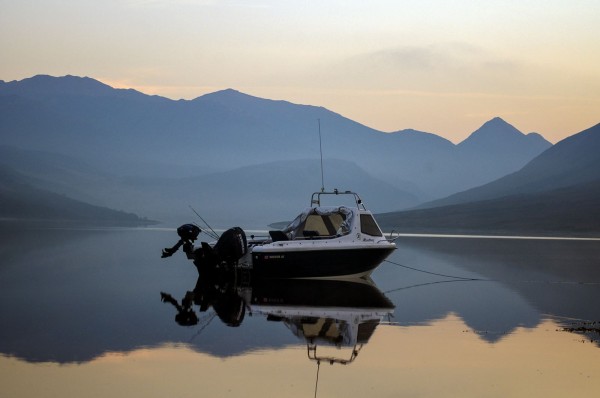
Why a Longliner 2?
The Longliner 2 will live at home and under cover, which means it can be loaded and pretty much ready to go at any time. A lot of my fishing is short notice, following the weather type stuff, so the extra flexibility is important and should encourage me to get out fishing more often. Dodging the cost of a boat park space is a welcome bonus too.
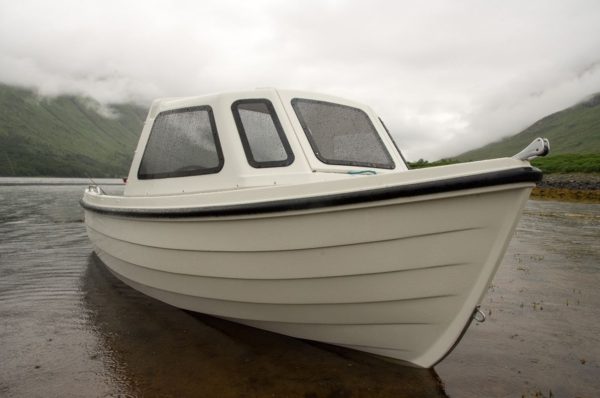
A biggie for me is that I get away from the horrors of a braked trailer and high levels of maintenance they demand. This is a really big plus point, as keeping a boat trailer legal is a major hassle if you’re not particularly mechanically minded.
The Orkney is definitely a slower boat but I’m no speed merchant and the practical difference over a typical 5-10 mile run is pretty minor, especially as sea conditions around Scotland rarely allow WOT running anyway. Orkney claim 22 knots (25mph) top speed but I doubt I’ll see that, and something in the 16-18 knot range works fine for me.
The LL2 is apparently an updated version of the older Orkney 520 hull and certainly isn’t directly descended from the original Longliner. So it’s a lot faster than the longliner and can take a larger outboard, although the max is 25hp. It’s max quoted speed is 22 knots compared to 30+ from the Warrior, although I rarely took the 165 much above 22-23 knots in practice.
You sometimes see the smaller Orkneys referred to as “starter” boats, which I’d disagree strongly with – I’ve had a boat for over 30 years now, and this is the first Orkney I’ve owned or even set foot in. It’s very much a question of working through what you need from a boat and choosing the right compromise for your needs. For me, just now, that points to the LL2, but obviously that might change again in future…
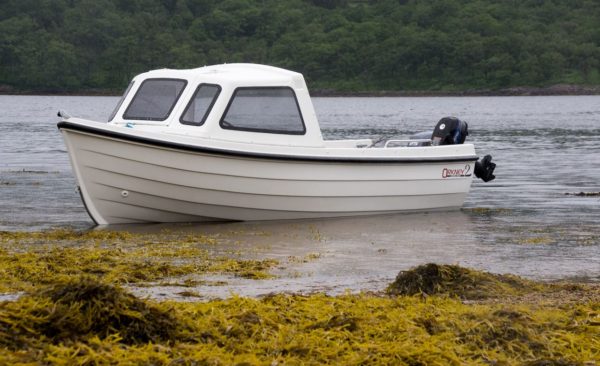
I’m not sure how closely my needs match yours or other anglers, but my main reasons for switching were:
- I trailer a boat thousands of miles a year. Braked trailers are a complete and utter pain to keep legal, so a move back to unbraked trailing is very appealing. A lighter boat is also easier to tow, although the Warrior is hardly difficult to move about, or launch, single handed.
- The LL2 will pretty much live at home, rather than in a compound miles away. This obviously saves a few bob, but the big benefit is that it makes it easier to drop everything and go fishing at short notice. I’ve noticed that I was using the Warrior less than I should simply because of the hassle of picking her up and putting her back in her compound.
- Being under cover and close at hand both reduces maintenance and makes it easier, as well as allowing her to be kept in fishing ready condition with gear aboard, etc.
- Most of my fishing is within a 10 mile radius of port and in reasonably easy waters – sea lochs, North Sea (Dunbar) and SW Scotland. Of these, only the tide races on the headlands around SW Scotland would bother me in a LL2 – and they bother me in a Warrior too. Basically I don’t really need the extra speed or brick like qualities of the 165 hull.
My LL2 will be set up to allow one person to fish and sleep overnight in reasonable comfort; allow two to fish in comfort; or fish three at a bit of a pinch (by comparison I’d regard the Warrior 165 as also fishing two in comfort, three at a pinch. I don’t think you can have four fishing safely on a 165). My longest 1 day trip in a Warrior is over 100 miles, and I expect the same capability from the Longliner 2, once properly set up.
Mine is configured with a hard cuddy, console and single seat box. This leaves quite a bit of room for fishing, although laid out differently from the Warrior style boats. I’m still working through the permutations for rod holders, etc. but have fitted a set of rails towards the stern which will help.
Maiden Trip
I took it out for a maiden launch and engine break-in session at the end of June over at Loch Etive. Not much wind but it rained from start to finish so the photos are fewer and soggier than originally planned.
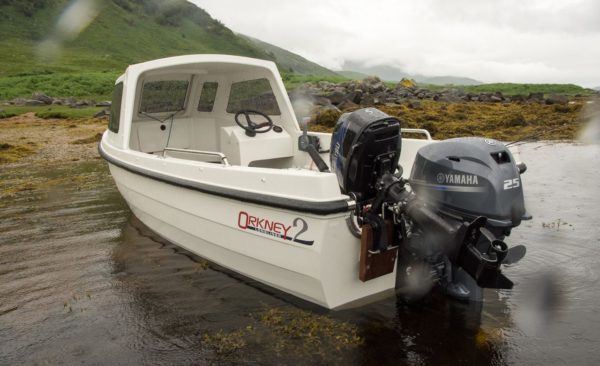
You can see the handrails on this photo, just immediately aft of the rowlocks(!). Also the console, which is quite a good size for this class of boat – I haven’t installed anything yet as I wanted a wee play about first before committing to anything. Trim was OK with one aboard, with a slight lean towards max revs (although the rather oversized Tohatsu aux at 25kg helps offset my weight [just a little!]). The cuddy is also a good size and provided decent shelter from the wet stuff.
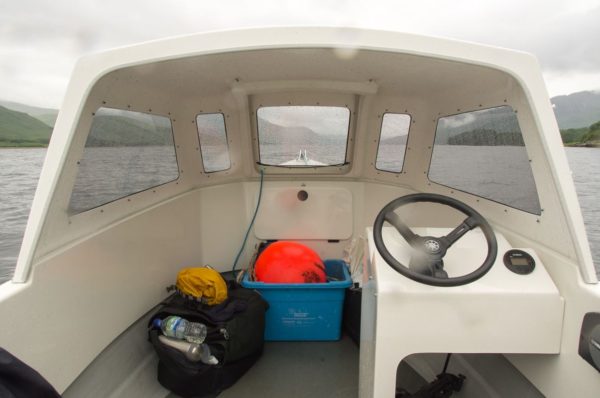
The anchor well is bigger than I thought, shown here with a 5kg Bruce and 10m of heavy chain. I didn’t keep the anchor in here whilst towing as the thought of it flying around in an accident didn’t appeal, but it looks big enough to hold my usual 200m of rope.
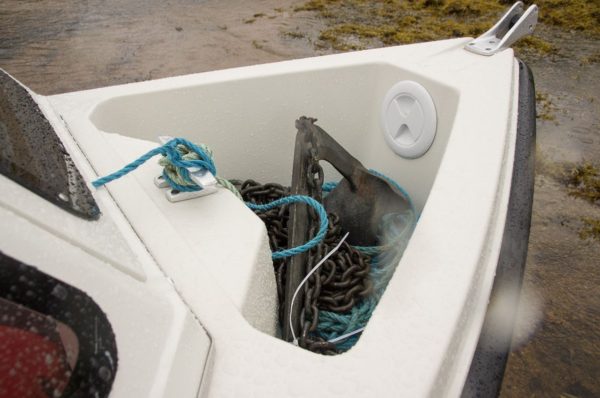
And a view towards the stern. Planning on putting at least one rodholder on each rail, plus one towards the stern itself.
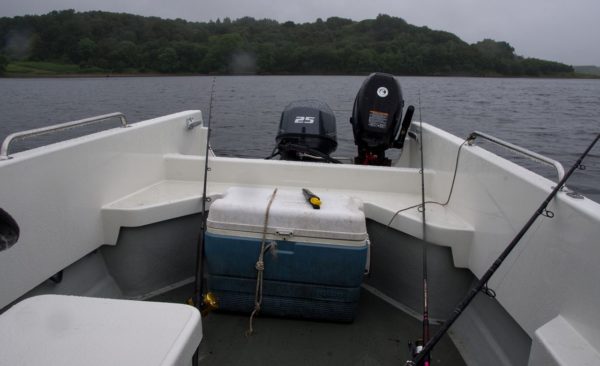
And a slight downside in wet weather – the bilge is too shallow to contain water effectively, so be prepared to bail out during the day if the rain is heavy.
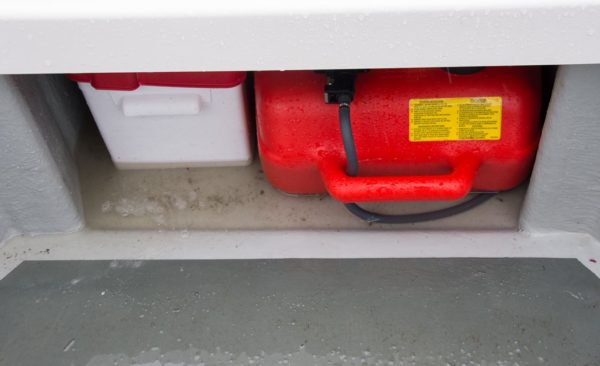
A couple more pics – sorry about the stray raindrops and generally grey look, but it was an authentically grey day of the sort that Scotland specialises in!
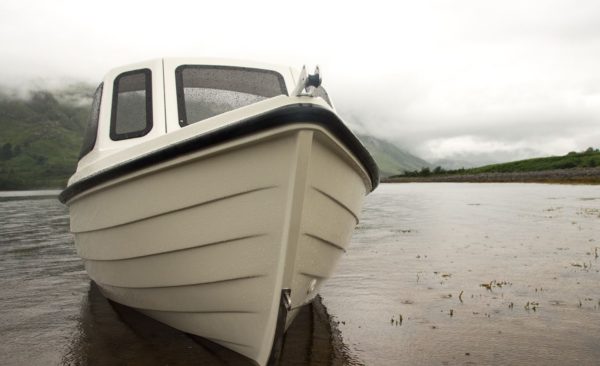
A view of the starboard side of the Orkney Longliner2
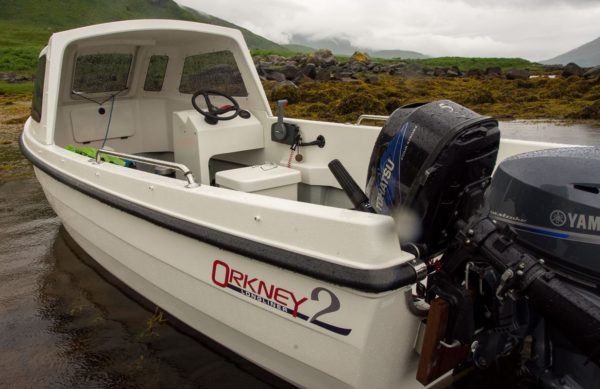
And finally – first fish, being a small and feisty grey gurnard.
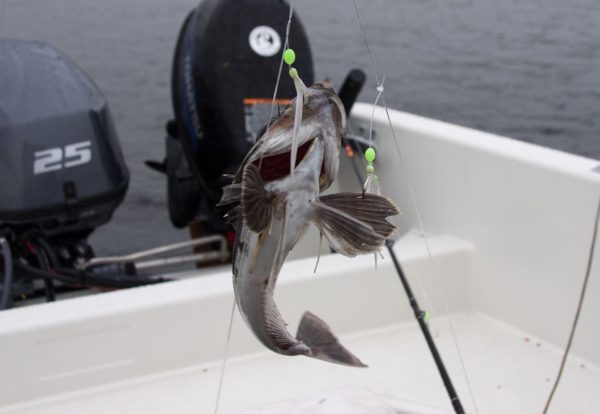
Overall everything behaved itself, although I picked up a few minor things to change. Performance is a little hard to judge with a new outboard, but I took her up briefly to max revs and hit 23-24mph (20.5 knots) on the GPS, so the claimed 22 knots when lightly laden looks about right given she wasn’t trimmed correctly at the time.
Anchoring was easy and she was well behaved in a slight wind against tide situation. Drifting seemed fairly stable, although it wasn’t rough enough to test this realistically.
All in all I’m happy with the trial run, although conditions were pretty benign if you forget about the rain. I think I’ll give it a few months to get familiar with her and then post a more considered review in the light of experience!
Share this:
like the new boat Doug. Had both the longliner and the strikeliner which would have been the hull before the 520. a half canopy would be a worthwhile investment. can fully understand the change, the trailer issue is a concern we all share.
I used to go everywhere in mine so no limits to a 165 other than speed on a calm day.
Hi Dale – Just back from a little run through Corryvreckan and right round Jura and she coped brilliantly. More just exploring than fishing, but she did everything asked of her, including acting as a rather large tent overnight…
Great read mate.
Great review, I’ve just purchased the same boat in a similar configuration (although 20HP rather than the 25 you have). I also had a similar rationale to you but also wanted a safe seaworthy boat for youngsters (both under 10), fishing and potting, and from my sea trials it definitely looks promising. I’m trying to source either a boat tent or canopy/awning for overnight stays, and seeing the water in the bilge I think I should have opted for the pump rather than bailer. Would definitely be interested in learning more on how you have configured your kit now you’ve had a few months.
Hi Adrian,
Thanks for your comment. I’ve had her out 8 or 9 times since I got her, mainly east coast drift fishing or on the west coast sea lochs but with one longer overnight trip. I’m still adding bits and pieces to her, so she’s now got 3 rodholders each side and grab rails on the cuddy roof, plus a seat for the seat box. I can’t help with the camping cover, although I find the standard cover leaves plenty space for me (maybe not for 3 of you!). I’ll probably write up a longer term look at the Longliner2 in a few months, but I’m still very happy with her.
Cheers
Doug
Thanks for the review i think uve convinced me to look for a second hand 520 i cant afford new and theres some very nice hardly used ones for 5-6k like u ive had heavy boats but age and cost of towing making a rethink
I long for a small fishing boat but can it be towed and launched without help and without too much stress and hasslerob
Short answer is yes. The trailer is the biggest hassle in my experience, but keep the bearings in good nick and the rest is easy. Get into a routine to make sure you tie it down correctly, plug in the lighting board, etc. and you’ll find things fall into place without having to think too much. On the road it really isn’t a problem, although you’ll be slower and need to mind potholes a lttle more.
Single handed launching is straightforward but you need to think about what you do with the boat whilst you park a car. I’m usually quick enough that I can park the bow on sand for 2 or 3 minutes (need to be careful that the tide doesn’t ground you/float you off). Sometimes I drop an anchor off the bow and just hold her a few feet from shore. You could hit difficulties coming back in on an exposed shoreline if the wind is blowing onshore. Normally I’d drop anchor just offshore and hold there whilst I wade ashore and get the car.
I can’t think of any problem I’ve actually experienced afloat that would be easier to deal with 2 aboard. Injury or falling overboard would be the obvious ones I guess.
Hi, 99 percent sure I will get a ll2. Going to have a look at the boat show Sept. I am looking for a fishing boat for inshore around Cornwall and a boat to visit those quiet sandy bays and stay over night. I do enjoy just pottering up and down the river with the family at a steady 4 or so knots. I like the idea of the cuddy being removable, is this an easy job? I like lure fishing and it would be perfect with the cuddy off then back on for winter fishing. I have a rib at the moment. How is the ll2 on the drift In a bit of sea , does she rock and roll a lot? A friend has the Orkney 440 we were out last week in a bit if a sea and he said he felt like he was in a washing machine were as my rib was well behaved. Always being told to get a warrior , but could do with out the braked trailer and I need to move it around on the trailer by hand so I don’t need the weight. Should be cheaper to run also. Love reading about your trips.
Hi Adrian,
I’ve never removed the cuddy so can’t say for sure, but I’ve just had a look and on my boat the cuddy is secured by 13 screws. So removeable, but probably not on a regular basis. You could always ask Orkney if they’ve any other suggestions.
I find that the LL2 tracks quite nicely on the drift, but it is a light boat and definitely sits on the water rather than in it, so it does rock’n’roll a bit. To be honest, with these nice big tubes and a low centre of gravity your RIB will probably out-perform most angling dinghies in terms of stability. I think it’s more noticeable when there are 2 or more aboard, as you automatically tend to fish from the centre of gravity if it’s just you aboard, which helps quite a bit.
Cheers,
Doug
Hi Adrian,
Sorry for late input, probably too late. I fish from this 16′ displacement boat http://www.arranboats.co.uk/
Slow but stable is the word(s) typically 6 knts in any conditions & super frugal at that speed. The large keels mean it sits extremely steady in the sea swell up to 2m & perhaps of more interest to you, is the fact that the cuddy cabin simply clips off to create an open boat, or even get under a height barrier. A day’s sea fishing for me typically means 3l-4l pf petrol.
Slow speed isn’t popular these days, but safe & stable it is.
I’m very pleased with my 2nd hand one & considering trading to a brand new one. Horses for course I suppose.
Sorry it’s so late, Cheers Doug.
Ash.
Hi
I have a LL” with yamaha F25 engine. Can you help with some questions I have re your tach meter? Also the handrails.
Thank You Pete
Hi i am thinking of buying a LL2. Now that you have the engine broke in was wondering what kind of top end speed are you getting thanks
Hi,
I almost never run her completely full on, but it would be around 23mph I think, lightly loaded with one aboard. Easy to hit 20+
With 2 aboard (neither of us lightweight) and gear, then more like 15-16 mph. I have seen 18-19 in completely flat calm, but that isn’t a realistic figure.
I’d three of us aboard for a few days this year and we were down to about 11-12 mph.
Hi like others I am interested in this boat. I have used my kayak on the sea for last 10 years with great enjoyment but as I get older fancy a boat. My concern is launching and retrieving – with the yak this is never an issue. With a boat like this however would I invariable need to launch from a slipway? My vehicle I’d a fairly new Octavia 1.6 no 4wd.
I also wanted to ask another probably really stupid question – is there anyway a boat like this could be transported on roof of my car (without Cuddy). Cheers. John
Hi John, The answer to your second question is a straightforward “no”. Bare boat weighs around 270kg so is far too heavy for car topping.
I spent 20 years towing with a 2 WD car and boats of similar weight, so it’s quite possible to launch off any hard ground. A beach is possible as well, provided there isn’t soft sand (often at the top of the beach rather than the bottom).
It’s often possible to unhitch the trailer and push it to the water’s edge, and to rope it out. You do need to take care if there’s anyone else about, and it’s a lot easier with two people.
You will often find that even very small wavelets will quickly start to bed trailer tyres into the sand – even a small amount will make it much more difficult to get the trailer moving again. I’d strongly recommend small boards under the wheels (even a plastic kitchen chopping board will really help). Never dip the wheels of your car if you can possibly avoid it, and move it at the slightest sign of bedding down.
Start with a slipway and get into the routine of launch and retrieval, so you can do it quickly. Then try out other launch sites once you’ve worked out your routine – you want to minimise time spent at the waters edge as that is what will get you bogged down.
Hi Just wondered how you are finding the ll2 some months on? Any regrets or niggles?
Hi Mike,
Very few issues really after around 4 years. I swapped out the bow roller for a slightly larger one as my chain kept jamming. I’d like to swap the seat box out for a removable pedestal seat, just to keep a clear deck if there are 3 aboard or we’re chasing larger fish. The bilge drainage I identified early on is still an occasional nuisance.
At some point I’d also like to upgrade to no feedback steering cables as I had this on the Warrior and it’s definitely worth the extra cash. Probably go for a nicer steering wheel as well.
Apart from that it performs pretty much as expected – a light boat with good sea keeping. Ideal for solo fishing, good for two and manageable with three. Compared to the Warrior you do notice the loss of deck space and slow performance (11-12 mph) if you have three aboard. That’s rarely an issue for me and is the trade off for a much easier life in respect of trailers and storage.
Apart from a couple of gelcoat chips I’ve not managed to break anything yet, although I keep trying.
Thank you for your update. Your review has been my best source of information for the ll2. I now have one on order and am looking forward to getting out on the water in dorset.